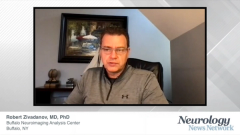
Realistic Outlook of Integrating Positive Remyelination Strategies in Clinical Trials
Robert Zivadinov, MD, PhD, provides thoughts on hurdles of conducting clinical trials that incorporate imaging techniques sensitive and specific to myelin for patients with multiple sclerosis.
Episodes in this series

Transcript below.
Robert Zivadinov, MD, PhD: As you can imagine, even before these measures make it to the clinic, they have to be utilized by at least most of the academic or big non-academic MS centers in order to be able to conduct these clinical trials. The selection process for this remyelination clinical trials is extremely detail oriented. It’s not just having the capability of having patients with MS, but also having those technical capabilities is crucial to the include. Those participating sites will need to have 3-test line MRI of the most recent release, which is going to have some of these sequences commercially available.
Getting sequences to be installed on these scanners is a tedious process, because somebody from the central side must go to an MS center and obtain the permission, which is not always an easy thing. The other thing is that the post-processing side, obtaining the scans and getting the measures, is certainly an area where we can make a lot of advances, mainly with the protocols of reporting and standardization of these measures. I see that this is going to allow only a few centers that are specialized to even conduct these trials. We will not be able to include 150-200 sites around the world like we are doing for the conventional MRI metrics in phase 3 trials.
On the other hand, we do not know which of these biomarkers or remyelination is the best. Is it the best to do visually-evoked potentials and just focus on the visual pathway? We then would take the patients after acute or chronic optic neuritis to test our therapy. Or is it going to be a spinal cord measure? Because you want to remyelinate spinal cord. Or are you going to look at whole brain? And all the lesions and particular regions in the brain that may remyelinate better than the others. This is all open.
The changes in MTR (magnetization transfer ratio) between time points have so far been the most robust MRI measure in clinical trials. We have done it; other centers have done it. It has been promising. I also should mention positron emission tomography because that has been discussed during the course and now there are commercially available agents like florbetapir. Those amyloid based agents that are already FDA-approved can be used to test their imagination. Using these agents may be more feasible in some of the trials because they can be easily delivered to different sites across the country. The 18-fluorodexyglucose based PET studies have a larger potential than carbon 11 based Pittsburgh compound-B (PIB) compound studies, where the half-life is extremely short at around 20 minutes.
Newsletter
Keep your finger on the pulse of neurology—subscribe to NeurologyLive for expert interviews, new data, and breakthrough treatment updates.























